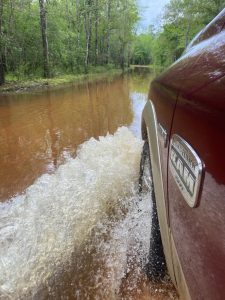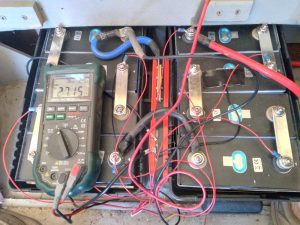I think where we were last time was I had the starboard battery assembled and was going to try for a run on the one lithium iron phosphate (LFP) battery bank and one of the old lead acid banks in reserve. Then we had a run of inclement weather, the river flooded and the other battery boxes came in. Well, they came close, left by the side of the road a quarter mile from the house. Yay, let’s build the second battery while the river is up and go all in with lithium. Then I discovered the battery boxes were too small, dash it all. Back to Plan A whilst new battery boxes are in transit. Ah, supply chain issues.
In the meantime I’ve have had a chance to let the starboard battery settle down and observe its behavior. I have also taken several opportunities to cuss the Daly BMS (battery management system) for a number of reasons.
First off, the instructions are horrible. Yes, there is a basic connection diagram you can follow and be all right, but there is more to it. When everything is properly connected, you then have to know how to turn it on. In fact, you have to know that you need to turn it on. Once on, I was pleased that I had not connected it to anything. The default parameters would likely kill the battery in no time. I don’t mean run it down, I mean destroy it. Don’t want to kill the battery, you know. Even on the cheap, this battery set me back thousands of bucks and that’s another story. The great deal on the battery cells and BMS units came at a time when John and Sun Electronics had this great sale on and I needed a pallet of really big panels for some project I know I will come up with someday. Now add two substantial solar purchases and the convenience of online banking…do you think my wife didn’t notice? She did! But Dear, it was ON SALE. That works for her, but not so much for me. Fortunately, this outflow coincided with dividend season at the brokerage and I didn’t have to give up eating.

So, back to the boat battery, the river flooded some more and the bigger battery boxes came in, or at least close enough. Back to Plan B, an all LFP-and-solar-powered boat. Last night I crawled back aboard Sun King and assembled the port battery. The big cares in the assembly are that the cells start out charged and balanced, the connections made correctly and then the battery BMS is properly programmed before throwing the breaker “on”. The defaults, as I started to explain earlier, are terrible. Some are understandable. The BMS factory can’t really know the size of the battery you are building, so you have to program it in. You can’t do that unless you have downloaded the app onto your phone. If you prefer to use a laptop, good luck with that. There are some fit and finish issues that precluded being able to plug in the USB cable on either unit.
However you get into contact with the BMS, when you go to program it, it will ask for a password. This is nowhere to be found in the documentation, that I could see. Fortunately, it may be one of the world’s worst kept secrets and you can find it in dozens of places online. 123456, so you know. The limit for output current was really unfortunate at 3000 amps, because the board is rated for 300 amps. There’s a 5kw inverter on the boat with really big capacitors that cause a really tremendous charging surge at first connection. Connecting might have blown up the BMS., but it was already charged by the lead battery. I am looking to add a precharge resistor on each breaker. A good size is sold for a few bucks for golf car solenoids for pretty much the same purpose. They are on Ebay.
The 9 wire balancer cable, which connects to every cell, is also the power source to run the BMS. Once that is plugged in, the battery can be turned on by pressing the button on the fuel gauge or SOC (state of charge) indicator. But back to the programming, you set minimum and maximum voltages, first to keep from killing the battery, and secondly to insure long life. If you charge to 100% and discharge to 0% the battery life will not be great. I am running around 90% on the top and 10-20% on the bottom. The two batteries are set up a little different so I have a little more in reserve in case I come to a halt, but still need to fix supper, or move to safer harbor. Just call up the phone app and dial in some more usable power. I will say that the phone app works great. It is fairly intuitive and starts right up. I wondered about adding the second battery, but just select the Bluetooth serial number of the battery you want and it connects immediately IF the battery is turned on. That is, if the SOC gauge is lit up.

The first battery seemed to behave oddly, at first. I concluded it was because the cells had been charged above the 90% setting I chose. I turned on a bunch of stuff in the boat and left it running. After a day, the battery was in the programmed range, the cells were balanced to .001 v and all was well. The second battery is in that phase, so I have left some lights on and expect the two to be cooperating, soon.
Now, my first mate and I are planning an all day trip down to Pensacola and back with a bit of seafood for lunch at a marina. Weather is not forecast to be the best day for solar performance, but this is a battery test, so I expect it to be splendid and maybe not so hot. The real test will be an overnight run, which I do to cross bays in calmer seas. This is a river boat and it is sometimes not good with bays. (I once crossed the Gulf of Mexico in it and once is enough)
Aside from the electrical capacity and reliability testing, the boat will be handling differently, too. I replaced 390 pounds of lead with 200 pounds of lithium. That will compensate for the forward passenger, this trip, but I will be eager to see how it sits on a solo run at a later date.
Okay, the title of this piece involved water moccasins and gila monsters. John saw pictures of some snakes encountered during some of my archaeological expeditions and he wants one. We have lots of them, but most are small. There was a big one in a tree over the river, but an attempt there ends up with the snake in your boat or kayak and a tendency to ruin the boat with machete chops and bullet holes. No, taking a snake needs to be done on land. Nonetheless, when we take our trip to Pensacola I will be on watch for a moc to send to John. A little gator might be safer, but down in Miami, gators are not a novelty. They are in ditches, canals, and swimming pools all over town. You don’t see a lot of stray dogs in Miami. Gators love them.
But John is not in Miami, now. He’s at his place in Arizona where they don’t have many gators. They have gila monsters! We don’t have gila monsters in Florida, so I want to trade him a moc for a gila. Come to think of it, gilas are kind of colorful. I think they’d fit in well down in Miami, except maybe for the humidity. Gators would not like the lack of humidity in Tucson. Maybe best to leave things alone. We haven’t figured out how to make the trade, either. USPS probably has a regulation and UPS has hazmat fees.

But back to the boat. Do I really need a battery that costs 50x what I paid for the hull? No, but this is a learning experience. Education costs money and lack of education can cost more. I am learning stuff to pass along to you who can learn something without spending the money. AND I can get some field evaluation of these cells and BMS and LFP in general before I spend a whole lot more to put them in the Solar Yacht projects. Not only that, Sun King should be able to recharge the long anticipated electric airplane that may finally be on its way. If the panels are not big enough, I can always add a bank of giant panels from the previously mentioned pallet I bought.
Next time, a performance report of Sun King on LFP battery.—Neal
